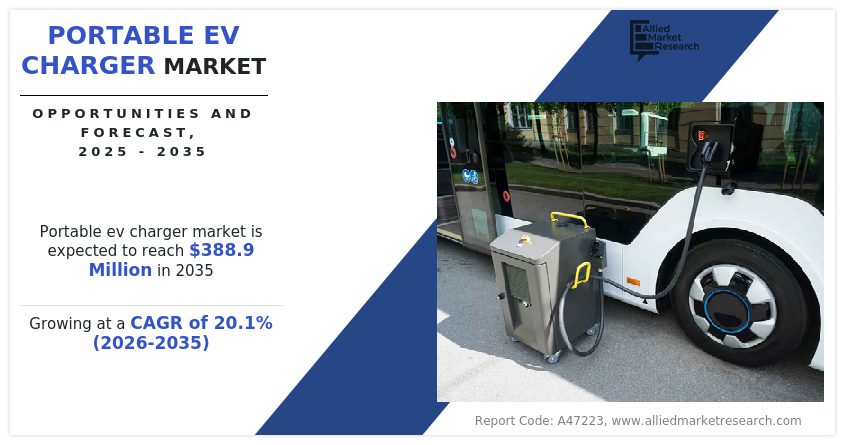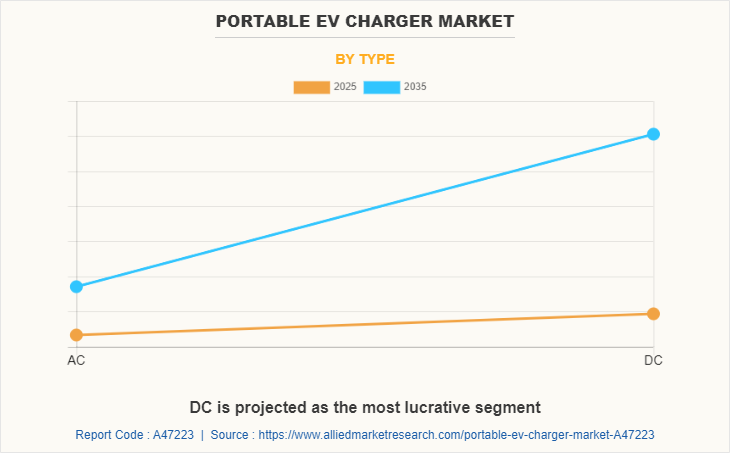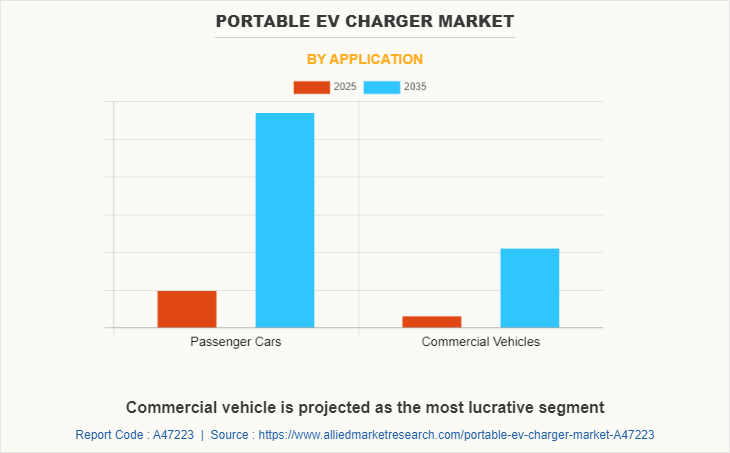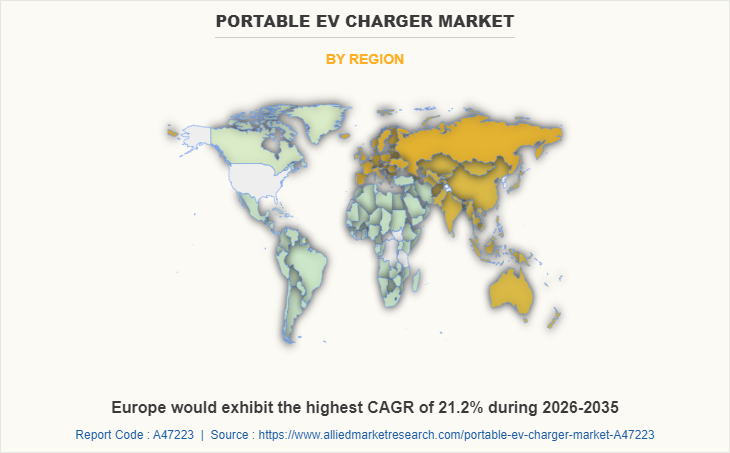Portable EV Charger Market Insights, 2035
The global portable EV charger market size is expected to be valued at USD 63.2 million in 2025, and is projected to reach USD 388.9 million by 2035, growing at a CAGR of 20.1% from 2026 to 2035.
A portable electric vehicle charger is a mobile charging unit used to charge electric vehicles at any location when the vehicle is away from home or charging stations. Portable electric vehicle chargers offer a simple and space-effective solution to the problem of charge point access. It differs from a stationary EV charger as it can be carried along with the user and is created specifically for mobile charging of EVs. Portable EV chargers are developed to be utilized at home, work, events, or other locations without access to charging stations.

The portable electric vehicle charger market is experiencing growth, which is driven by the rise in sales of electric vehicles, limited electric vehicle charging infrastructure, lack of standardization of EV charging, and increase in demand for convenience and reduction of range anxiety. However, the high cost of portable electric vehicle chargers hampers the growth of the market. Moreover, the development of wireless, bi-directional chargers, and fast chargers, emergence of mobile charging as a service, and the growing trend of shared mobility are major factors that are expected to provide lucrative opportunities for the expansion of the global market during the forecast period.
The portable electric vehicle charger market is segmented into type, application, and region. By type, the market is bifurcated into AC and DC. Depending on application, it is segregated into passenger cars and commercial vehicles. Region wise, it is analyzed across North America, Europe, Asia-Pacific, and LAMEA.
Asia-Pacific possesses high growth potential, owing to the rapid upsurge in the number of electric vehicles in countries such as China, India, and Japan. Several government initiatives for the development of electric vehicle charging are expected to boost the growth of the portable EV charger market in this region. Moreover, huge investments in the expansion of the electric vehicle industry are expected to drive the growth of the market.
For instance, in December 2020, Japan announced a $708 billion economic stimulus package. This package comprised approximately $384.5 billion in direct fiscal spending to decrease carbon emissions and foster digital innovation. In addition, electric vehicle charging manufacturers in various countries of the region provide portable charging solutions to eliminate the need for complex and costly electrical infrastructure. For instance, Wonder New Energy Technology, Ltd in Beijing, China offers mobile electric vehicle chargers with a battery capacity of 6KWh and output power of 20kW. Such factors are expected to provide opportunities for the growth of the global portable EV charger market.
The Chinese government allows substantial tax exemptions for the purchase of electric vehicles to promote their adoption. For instance, in April 2020, the Chinese government introduced a 10% service tax exemption for electric vehicles to stimulate demand in the market. Therefore, an increase in the use and popularity of electric vehicles owing to supportive government schemes and incentives is expected to boost the growth of the market. Moreover, the rise in demand for the development of portable chargers to provide stable power in times of need and reduce range anxiety among users is expected to drive the growth of the market. For instance, Guangzhou Electway Technology Co., Ltd a manufacturer of electric vehicle chargers provides portable electric vehicle chargers such as DC fast EV portable charger7KW CCS CHAdeMO portable charger, 60KW portable super EV charger for taxi, and others for various applications.

Numerous initiatives taken by the government of Japan, such as tax refunds, subsidies, subsidies, and various other non-monetary benefits related to vehicle registration continue to expand the portable EV charging industry. For instance, in November 2021, Japan doubled electric vehicle (EV) purchase incentives to up to $7,000. The government plans to allocate $329 million in subsidies in 2021 supplementary budget. This is expected to boost sales of electric vehicles and further drive the growth of the market. Moreover, according to charging station provider e-Mobility Power, there were18 places in Japan where no charging facilities exist within a 70km stretch in 2021. Therefore, the lack of charging infrastructure is expected to boost the growth of the portable EV charger market.
Prominent players profiled in the global portable EV charger market report include JTM Power Limited, Evteq Mobility Private Limited, Heliox Energy, Guangzhou Electway Technology Co., Ltd, Blink Charging Co., Power Sonic Corporation, Shenzhen SETEC Power Co., Ltd., ZipCharge Limited, SparkCharge, and FreeWire Technologies, Inc. The prominent companies operating in the market are adopting strategies such as product launch, contracts, and expansion to strengthen their market position.
In April 2022, Heliox Energy signed a supply agreement with PACCAR Parts to support the introduction of Pacific Car and Foundry Company (PACCAR) electric vehicles in North America. According to the agreement, Heliox is expected to supply mobile 25 kW and 50 kW chargers to Pacific Car and Foundry Company (PACCAR) dealers and customers, further building their electric truck fleets. In March 2020, Blink Charging Co. announced the launch and immediate availability of a mobile, reliable, affordable, portable EV charger designed to reduce concerns related to range anxiety for prospective electric vehicle drivers.
Rise in sales of electric vehicles
Transportation relies heavily on fossil fuels which has increased air pollution, resulting in a sharp rise in the prevalence of various respiratory and other ailments in the global population. Therefore, the increase in demand for clean transportation has promoted awareness, increased charging opportunities, and facilitated the adoption of electric vehicles. There is a surge in the popularity of electric vehicles owing to the several advantages provided by electric vehicles over internal combustion vehicles (ICEVs) that use fossil fuels.
Electric vehicles provide advantages such as no tailpipe emissions, no oil dependency, better fuel economy, less maintenance, and a better driving experience. Therefore, the sales of electric vehicles have increased significantly. For instance, according to IEA, electric vehicle sales reached 6.6 million in 2021. In the first quarter of 2022, EV sales reached 2 million, a 75% increase compared to the first three months of 2021.
The government of various countries have undertaken multiple initiatives to promote the manufacturing and adoption of electric vehicles. Governments in various developed and developing countries offer subsidies to consumers to encourage the adoption of electric vehicles. For instance, in February 2022, the government of India tripled its budgetary allocation for the scheme to subsidize the purchase of electric vehicles. Such supportive initiatives and schemes from the government have driven the sales of electric vehicles, which is expected to drive the growth of the portable electric vehicle charger market.

Limited electric vehicle charging infrastructure
The global market for electric vehicles is expected to grow significantly. However, the popularity of electric vehicles has not matched the infrastructure, and the required charging stations are not widespread enough to encourage consumers to adapt to the new eco-friendly mode of transportation. The expansion of charging infrastructure is currently at a nascent stage. Installing charging infrastructure faces many challenges, especially in urban areas.
Moreover, public charging infrastructure, especially fast charging, is very capital-intensive and has a long payback period. According to IEA, the number of publicly accessible chargers increased by 37% in 2021, which is lower than the growth rate in 2020 (45%) and the pre-pandemic rollout rate. The inability to access efficient charging stations acts as a critical barrier to the purchase of electric vehicles.
Charging issues are the biggest obstacle to EV adoption. This is caused by slow charging speeds, inaccessible chargers, charger cost, and vehicle-to-vehicle charging variability. Portable chargers do not need installation and are affordable and convenient to carry. Electric vehicle users can use portable chargers to charge the vehicle at any location. Portable vehicle chargers can solve the charging needs of the customers during the unavailability of charging infrastructure. Therefore, lack of access to charging infrastructure is expected to drive the adoption of the portable electric vehicle charger and drive the growth of the market.
Lack of standardization of EV charging
Standards play an important role in the development and use of technology in society, forming an essential foundation for broad market penetration and customer convenience. Standardization of charging protocols and devices is necessary to attract new players in the development of charging infrastructure and strengthen charging networks in ways that can increase customer confidence in their EV purchasing decisions. Automakers have designed charging solutions to differentiate their individual brands. A unique charging port design defines unique charging parameters, such as voltage and current, depending on the battery chemistry to extend battery life.
Therefore, fluctuations in charging loads emphasize the need for standardization of electric vehicle charging stations. Certain electric vehicle charging stations may only support certain types of voltage. For instance, AC chargers provide 120 V AC via Tier 1 chargers and 208/240 V AC via Tier 2 chargers, while DC chargers provide fast charging at 480 VAC. Moreover, new charging technologies such as fast charging and inductive charging solutions have emerged which demand proper standardization. Therefore, the lack of standardization is expected to boost the growth of the market.
Emergence of mobile charging as a service
Mobile charging services include delivering on demand charging to customers’ locations with a portable electric vehicle charger. The customer is required to pay for on-demand electric vehicle mobile charging services usually in the form of payment for their charging needs. Mobile charging services provide a charging solution to avoid the high initial costs of installing fixed charging infrastructure. The services offer flexible charging solutions in large events where there is no fixed charging infrastructure for temporary charging.
Some mobile charging services also provide customers with mobile applications through which they can order charging services. For instance, in May 2022, SparkCharge launched its own SparkCharge service which offers mobile charging services. The service vehicle arrives at the customer’s location with a portable charging system called the Roadie to provide DC fast charging. Such developments are expected to provide significant opportunities for the growth of the market.

Key Benefits For Stakeholders
- This report provides a quantitative analysis of the market segments, current trends, estimations, and dynamics of the portable EV charger market analysis from 2025 to 2035 to identify the prevailing portable EV charger market opportunities.
- The market research is offered along with information related to key drivers, restraints, and opportunities.
- Porter's five forces analysis highlights the potency of buyers and suppliers to enable stakeholders make profit-oriented business decisions and strengthen their supplier-buyer network.
- In-depth analysis of the portable EV charger market segmentation assists to determine the prevailing market opportunities.
- Major countries in each region are mapped according to their revenue contribution to the global market.
- Market player positioning facilitates benchmarking and provides a clear understanding of the present position of the market players.
- The report includes the analysis of the regional as well as global portable EV charger market trends, key players, market segments, application areas, and market growth strategies.
Portable EV Charger Market Report Highlights
| Aspects | Details |
| Market Size By 2035 | USD 388.9 million |
| Growth Rate | CAGR of 20.1% |
| Forecast period | 2025 - 2035 |
| Report Pages | 264 |
| By Type |
|
| By Application |
|
| By Region |
|
| Key Market Players | Evteq Mobility Private Limited, Power Sonic Corporation, Heliox Energy, FreeWire Technologies, Inc., SparkCharge, JTM Power Limited, Blink Charging Co., Shenzhen SETEC Power Co., Ltd., Guangzhou Electway Technology Co., Ltd, ZipCharge Limited |
Analyst Review
The global portable EV charger market is expected to witness growth during the forecast period. Range anxiety is a common concern for owners of electric vehicles. Development of portable electric vehicle chargers is gradually increasing to address barriers of electric vehicle adoption and ensure easy charging of electric vehicles.
Electric vehicle charger manufacturers are developing innovative and portable charging solutions to reduce concerns regarding range anxiety. For instance, in April 2020, Blink Charging Co. announced the launch of a mobile, reliable, inexpensive, portable EV charger that is developed to decrease the range anxiety concern among electric vehicle users. Up to 9.6kW of charge can be obtained from the free-standing mobile EV charging station, which supports 240-volt AC charging.
There is an increase in innovation in charging technologies of electric vehicles for high mileage/long distance driving and large fleets. As the production of electric vehicles increases, the need for fast charging has grown rapidly. Moreover, as EV battery capacities continue to increase, higher peak power is possible in combination with improvements in charging technology such as wireless charging systems, resulting in faster charging speeds. In addition, there is surge in development of portable electric vehicle chargers such as portable DC fast chargers. Such developments are expected to provide significant opportunities for the growth of the market.
The global portable EV charger market would be valued at $63.2 million in 2025 and is projected to reach $388.9 million in 2035, registering a CAGR of 20.1%.
The top companies in the portable EV charger market include JTM Power Limited, Evteq Mobility Private Limited, Heliox Energy, Guangzhou Electway Technology Co., Ltd, Blink Charging Co., Power Sonic Corporation, Shenzhen SETEC Power Co., Ltd., ZipCharge Limited, SparkCharge, and FreeWire Technologies, Inc.
The largest regional market for portable EV charger is expected to be Asia-Pacific.
The leading application of portable EV chargers is expected to be passenger cars.
The upcoming trends in the portable EV charger market include rise in demand for electric vehicles, growing adoption of shared mobility, and emergence of mobile charging as a service.
Loading Table Of Content...



